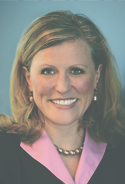AHP Connect Member Profile - Mary Hendricks
Allana Schwaab
Published: 09/03/2019
 Mary Hendricks, CFRE
Mary Hendricks, CFRE
Director of Philanthropy
The Foundation for Barnes-Jewish Hospital
St. Louis, MO
AHP member since 1999
Tell me about your start in health care development.
I started in health care philanthropy in 1998 at Children’s Mercy Hospital in Kansas City, Missouri as a regional affairs coordinator. That position gave me a really comprehensive perspective about all aspects of donor development. I met with and engaged a variety of donors — from individuals in the Legacy Society and volunteers leading our Regional Council to United Way organizations and even a couple of Girl Scout troops. I traveled throughout 150 counties in Missouri and Kansas, meeting with many generous and caring people. That’s how I got my start.
What drew you to the health care arena specifically?
I was drawn to the inspiration and iconic place that Children’s Mercy was and is in the Kansas City community. I think most children’s hospitals are held with similar esteem by their cities. After getting there, I learned as I went. I grew up in a way — in terms of my philanthropy career. I worked with inspiring individuals who mentored and taught me about the unique way patient and family gratitude can engage and inspire philanthropy. I spent 16 years at Children’s Mercy and just celebrated five years with The Foundation for Barnes-Jewish Hospital in Saint Louis. I’ve seen changes in health care and philanthropy along the way — I think knowing the impact that philanthropy can and does have on the mission is the compelling part. It is the reason I love the work. Now, being a part of this academic medical center and seeing philanthropy support research that influences outcomes and changes people’s lives all over the world — it is the ripple effect that is inspiring.
What area of giving are you and your foundation most focused on right now?
I hate this term because I feel it can be off-putting to some people, but major gift work is where transformation happens and that’s where every member of our team has to be focused. They have to know who our top donors are and who we are close to moving to the next commitment or who we are stewarding for having made a transformational gift. Whether it is the events team, our annual giving and stewardship program or our grants and awards team, we are all inspired by major gifts.
What are some recent successes you’ve had?
Without question, the opening of Evelyn’s House — our hospice house in St. Louis. Its opening has been a catalyst for other conversations that are really moving the needle. It has shifted conversations throughout our community and resulted in other significant gifts to fund a new division in the Washington University School of Medicine focused on palliative medicine. With the new division, we have leadership in thought and care that will influence the delivery of care that happens throughout our system. Our philanthropy is systemwide — we’re not just one hospital. While each hospital has its own foundation, at The Foundation for Barnes-Jewish Hospital we also raise money for several other organizations within the system.
From the university to hospice care, how do you approach fundraising in such different areas?
Different models can be challenging and simultaneously invigorating. The straight-forward grateful patient model that we try to use with physician-relationship fundraising efforts is different than the model we are using for hospice or the school of nursing. At the end of the day it is all about relationships — whether we are engaging physician partners, patients and families who are grateful for care or nursing school alums.
You mentioned engagement with physicians — how do you approach that relationship with them?
Physician relationships are key to our success. When we have engaged partners with vision and goals aligned with the priorities of BJC HealthCare, we can engage philanthropy that makes amazing things happen. Working toward big picture goals inspires investments that transform more than just a research study or a new piece of equipment.
You did the AHP Residency Program during the 2017-2018 cycle. Tell me about that experience.
It was very eye-opening in terms of learning more about AHP and understanding that — as the saying goes — if you’ve seen one system, you’ve only seen one system. Every single one of us has different models and different issues but the similarities of politics, hierarchy and donor fatigue — we’re all the same in those senses. We all have issues related to engaging our colleagues in operations and having a quid pro quo with them. Seeing other models of philanthropy and to meet and engage with those people — it was meaningful. A very worthwhile experience.
Was there anything you learned in the Residency Program meetings that you immediately wanted to bring back and implement in your shop?
There’s one that we’re working on — we’re not there yet. MedStar Georgetown’s model has become integrated into their patient experience operations and knowing how that has had residual impact on donor acquisition is amazing. The language they use in their model is also inspiring. We talk about how we teach our clinical partners to accept gratitude and not leave it on the table, and that’s something I learned from one little webinar. It may be a small idea, but it’s tangible.
What is the most rewarding thing about working in health care philanthropy?
What I find most rewarding is knowing that my efforts — not directly related to patient care, research or training anyone on that clinical side — are helping that ripple that goes around the world. Knowing that I’m engaging philanthropy that is transforming the care and elevating the conversation surrounding it.